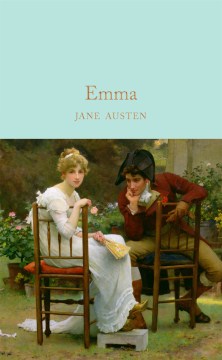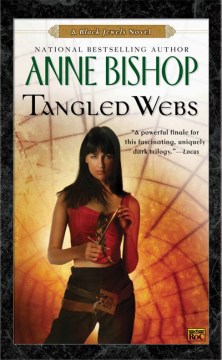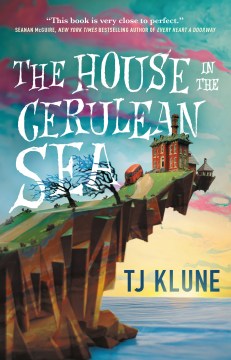Let me start this mini-lecture with some definitions, so we’re all on the same page with how certain terms are being used below:
Genre: A category of artistic composition, as in music or literature, characterized by similarities in form, style or subject matter.
Medieval: For my intents and purposes, the British medieval period ran from approximately 450 CE to about Shakespeare’s time, the early 1600’s CE.
Literature: It may be surprising to hear, but even literary academics like myself don’t agree on a standard definition for what works of writing are considered “literature” as opposed to “just” books/novels/poetry/etc. and the conversation can get heated. When I say literature, I mean the written word. This lecture in particular will focus on works of fiction.
Western Canon: The Western canon is the body of high culture literature, music, philosophy and works of art that is highly valued in the West: works that have achieved the status of classics.
Literary Canon: Pieces of literature considered essential, important, etc., to the relevant culture and time.
Modern/Contemporary: While there is a slight difference between what is considered the modern vs. contemporary era, for the most part the words can be interchangeable, and refer to the period from about WWII to today.
Novel: a fictitious prose narrative of book length, typically representing character and action with some degree of realism.
Motif: a distinctive feature or dominant idea in an artistic or literary composition.
When it comes to place works of literature into a genre, definitions can get a bit fuzzy and complicated, sometimes overlapping, sometimes neglecting certain aspects; not every work can be easily classified, and that’s ok! For the casual reader, genre may be used mostly as a means to determine the types and styles of books you like to read, and not much else. On the 3rd floor of the library, we categorize our books into broad categories for simplicity:
Nonfiction- with subcategory “Biography” at the beginning of the section, and the remainder of nonfiction following Dewey Decimal System organization. There is a small section of non-circulating reference materials, as well as a curated collection of Homeschool-oriented materials at the end of those shelving units, too.
Fiction- with subcategories “Mystery,” “Science Fiction,” “Fantasy,” “African-American,” “Romance,” and “Graphic Novels.”
You might recognize these categories and have a thought about the kinds of books you’d find within, and you might also feel like a major category has been neglected. This is part of the difficulty of genre classification. “Thriller” may be a popular type of mystery novel, but sometimes fits more in horror, or science fiction, as one example. Other genres have subgenres, ways to further classify specific types of work within that area. My favorite subgenre of fantasy, for example, is called “Space Opera”, which basically is a fantasy work that takes place in space and is probably melodramatic in some way (think Star Wars). Still other examples come from authors who dabble in multiple genres; they may find their bibliographies split between a number of sections in our library.
Which brings us to the genre of the day: Romance.

When I say Romance, you might think about Fabio, as pictured above on a 1997 poster from the American Library Association’s push to encourage leisure reading through the late 80’s and 90’s. This is certainly the bulk of modern romance as a genre: a book where the plot focuses on the romantic relationship between two people, probably has a happy ending either with a marriage or the consummations/continuation of a significant relationship. There’s this common idea that romance is “chick lit”, aka, written by women, for women, without the level of depth or characterization expected in other more “academic” genres. This is ridiculous. You can certainly have a preference for not enjoying romance, but to categorize the entire genre as patently non-academic, and by extension, non-valuable, is a mistake.
Medieval Romance
Romance, in its initial creation, came from the medieval period. What set these stories apart from other writing of the time began with the language used. You may have heard languages such as French or Italian referred to as “romance languages” and that is because of their origin. Romance languages stemmed from the Latin in use at the time, and when authors began writing, not in Latin, but in their mother tongues, the association between using romance languages and romance as a genre began.
Medieval Romance as a distinct genre followed specific structures and plot points. This is where the origins of King Arthur can be dated to, and the 12th century French author Chrétien de Troyes, writing in French, is credited with not only the creation of the vital character Lancelot, but the creation of a recognizable genre. Romances often were stories of Knights and Kings overcoming great odds. There was questing and adventure, and the winning of beautiful ladies through feats of prowess and ability. There was always a “happy” ending, or at the least, the consummation of a relationship. Pictured below: the opening pages of 14th century Sir Gawain and the Green Knight which can be found in its entirety on the British Library Online.
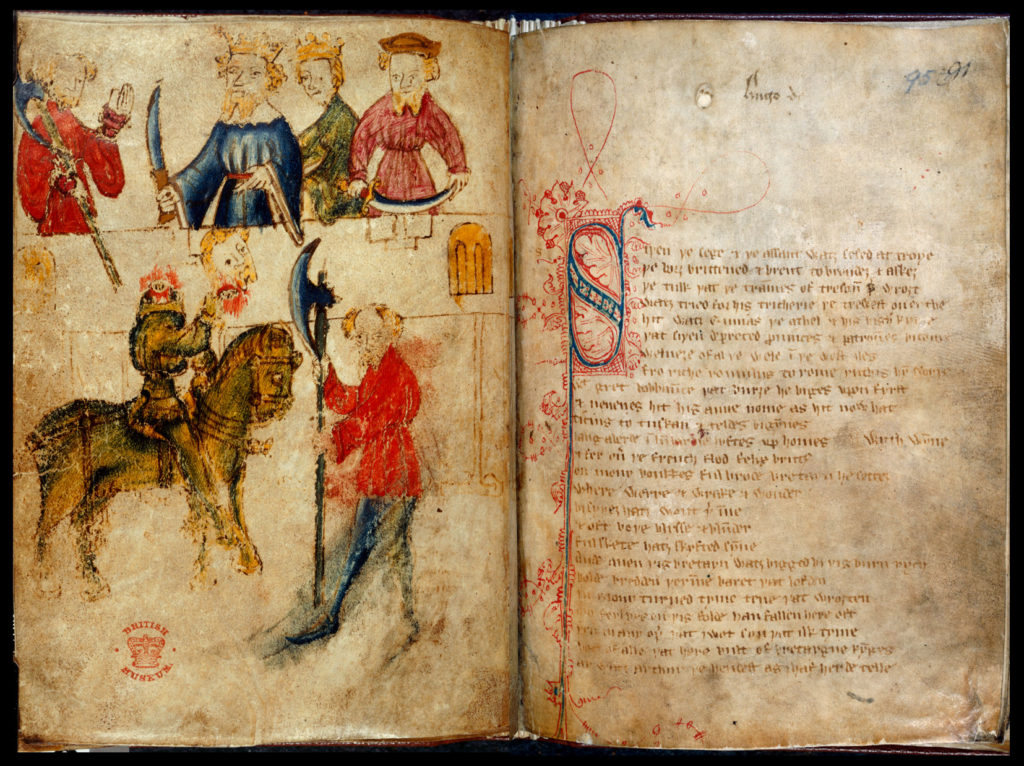
Magic and the supernatural played a large part in medieval romance. Magic, to medieval audiences, was absolutely real and recognizable as a literary story telling device. Otherworldly creatures also played prominent roles in many romances, ranging from beautiful fairy Queens to the absurd Questing Beast. For a medieval audience, the inclusion of magic was not necessarily a sign of otherworldliness or difference, magic was just part and parcel their world and was present in the vast majority of romances.
The morph from medieval romance into modern romance wasn’t linear and isn’t an exact fit, but I think a lot of the recognizable themes from the medieval period are present in romance literature today. What may be surprising in this day and age, that helps explain the shifting in genres, is the importance of the novel. With the advent of the novel, a self-contained story that didn’t necessarily have to rely on cultural memory or prior oral story-telling, authors and audiences could access a much wider variety of texts. And then, in the 1930’s, a British publisher began producing mass market paperback romance novels, marketed to women specifically.
Modern and Contemporary Romances
It wasn’t for another handful of decades that this publisher, known as Harlequin Enterprises Ltd. on this side of the Atlantic, published their first Mass Market Paperback romance novel in the United States: Kathleen Woodiwiss’s The Flame and the Flower in 1972. Woodiwiss was a fascinating author, and one I’ve known since long before I made the decision to pursue literature studies in my post-graduate schooling. You see, my mother had read these novels as a teenager and loved them. My birth name came from a 1981 Woodiwiss novel, A Rose in Winter, I still own the copy of my mother’s that is now worn and faded, though I have not attempted to reread it in quite some time. Here is the cover of the edition we owned:

Title: A Rose in Winter
Author: Kathleen Woodiwiss
Publication: 1981 Avon Books; Avon remained Woodiwiss’s ONLY paperback publisher, after rejection from numerous other publishing houses owing to the length and complexity of The Flame and the Flower‘s plot. It was thought there was no market for complex narratives with a predominantly female audience.
Can I Read Woodiwiss?: Many of Woodiwiss’s books are out of print, making them harder to come by. There are a handful of titles available electronically through Libby and a number of physical copies available in our shared network of libraries, making it easy to have a copy sent over to Fountaindale. You can browse all of here available titles in our catalog here.
I remember distinctly I was not allowed to read this book, despite the character being my namesake, until I was 16 years old because of the sexual content inside. Dear reader, I did NOT wait until I was sixteen, instead traipsing off to the library to read it when I was about 12 or so. I’m sure, on this initial read, many of the sexual innuendos and content went right over my head. When I read it again a handful of years later, I picked up on a lot more, but not enough to make sense of why my mother felt it was so highly inappropriate. By the time I was 20 I read far more raunchy pieces of literature from other genres, notably epic fantasy like Game of Thrones, and even the movies and TV shows on air at the time handled more explicit content. It wasn’t necessarily the depictions of sex involved, in Woodiwiss’s case, however. It’s true, she is credited with the inclusion of more sexual content than her predecessors, who would often “fade to black” and end a chapter as soon as it was clear two characters were alone in the bedroom, or what have you. The problem I have as an adult is the depiction of “love” and “romance” wherein most of Woodiwiss’s female characters eventually fall in love with a male character that has captured/raped/ridiculed/etc. them already.
Woodiwiss received the Lifetime Achievement Award from the Romance Writers of America in 1988 for her career in romance writing. Other notable early contemporary romance authors included names such as 1989 RWA award winner Eleanor Hibbert, whose 9 total pen names published over 200 historical or gothic romance novels by the time of her death in 1993, as well as 1992 RWA award winner Mary Stewart, whose turn to the Arthurian in her Crystal Cave quintet melds her romance roots with Arthurian fantasy and magic.
Structure & Motif, in Brief
Modern romance has a more fluid structure than medieval; there isn’t necessarily a quest or adventure, and there’s rarely a need for magic or the supernatural outside of paranormal subgenres. Modern romance novels place the romantic relationship between characters to the forefront, the plot revolves around the progress of said relationship rather than on solely external factors. Like with its medieval contemporary, there is probably a happy or satisfying ending. Medieval romance didn’t often illustrate the physical aspects of romantic love, either. Sometimes this was because the love relationship, such as between Lancelot and Guinevere, was inappropriate outside the bounds of story telling. Sometimes it was simply because love and sex were not always conflated together, as they so often seem to be today.
Like in any genre, romance novels can run the gambit from beach reads, requiring less focus and concentration to follow, to complex plot driven story arcs lasting multiple books. It is reductive to assume all romance novels fall into the former category, and even if they did, it’s unfair to say that there is no value in something of that nature. Academic elitism, which is to say, the way in which scholars assume certain work to have inherent value and that it is therefore better than other works, is a major problem. Combine that with the casual misogyny of our culture which tends to subconsciously devalue things preferred or created by women, and modern romance as a genre is a perfect storm of disregarded content.
There are so many subgenres of Romance, and other genres have subgenres of their own that get to add a romance tag onto themselves. Fantasy Romance, for example, are books that may be primarily fantasy in nature, but the inclusion of romance motifs is strong enough and vital enough to also be tagged on. Many of my favorite romances are not solely romance, but romance mixed with something else. Magic, too, has largely left the genre as our culture itself has moved away from the mystical permeating our daily lives, save for the magic inclusions in the aforementioned paranormal subgenres.
Reading and Watching Recommendations
As you can see, it is no easy feat to narrow the genre of romance into a small and containable category, suitable only for a specific demographic. While it is true that the continued evolution of the romance genre owes itself to the work of progressive women, romance should not be viewed as lesser simply through it’s association with the feminine. If your conception of romance only occupies a specific category, say Bridgerton, perhaps the variety of subgenres on the below list would be helpful.
Title: Emma
Author: Jane Austen
Subgenre: Classic Romance; Manners & Etiquette
For Fans of: 19th Century; Jane Austen would be considered a classic and while the go-to title seems to be Pride and Prejudice, I feel the adaptations of Emma make it equally enjoyable. My favorite of Austen’s work is the less popular Mansfield Park, which takes the poor relation turned governess motif also found in Jane Eyre, but with more humor, in my opinion.
Find It: DVD; Blu-ray; Manga Adaptation; eBook on Libby; Physical copy.
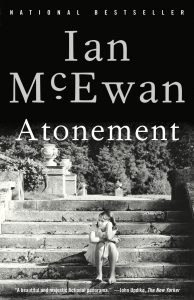
Title: Atonement
Author: Ian McEwan
Subgenre: Coming of Age; Tragic
For Fans of: Jane Austen; the Bronte sisters; The English Patient; Ian McEwan’s writing is incredibly beautiful. I first saw the film adaptation directed by Joe Wright (who also helmed a Pride and Prejudice film) which is atmospheric and gorgeous, capturing the feel of the narrator incredibly well. There are many similarities between McEwan’s approach to romance and his predecessor Austen, but you will find Atonement much more bleak, with less focus on the happy ending.
Title: Tangled Webs
Author: Anne Bishop
Subgenre: Fantasy Romance; Mystery
For Fans of: Magic, courtly intrigue, fantasy genres; The Black Jewels series by Anne Bishop is one of my favorites. Bishop takes the recognizable themes and structures of medieval courts, but flips them to female-centric power houses. Add in innate magic all characters can be born to, complete with an unmovable caste system dependent on your magic as it appears to you at birth, and Bishop’s worlds emulate the medieval in a delightful way.
Find It: Physical copy;
Note: Tangled Webs is technically part of the Black Jewels series, but can be read alone. Bishop’s slightly less romantic series that begins with Written in Red can also be found upstairs, as well as eBook on Libby.
Title: The House in the Cerulean Sea
Author: TJ Klune
Subgenre: Fantasy;
For Fans of: Magic, found family, later-in-life love. TJ Klune offers queer romance, but in the perfect way. The point of his characters or his plots is not that they are queer, they simply are. The House in the Cerulean Sea melds fantasy with boarding schools, boardrooms with the wilderness, and I loved every moment of it.
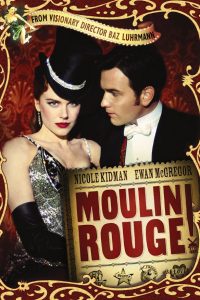
Honorable Mention
Title: Moulin Rouge
For Fans of: Musicals, the 19th century, tragic love, magical realism and contemporary music. This is my favorite movie of all time, and I can’t include a list of romances without putting it on there. It has recently been adapted for Broadway, as well.
Find it: DVD; Blu-ray; Soundtrack.

